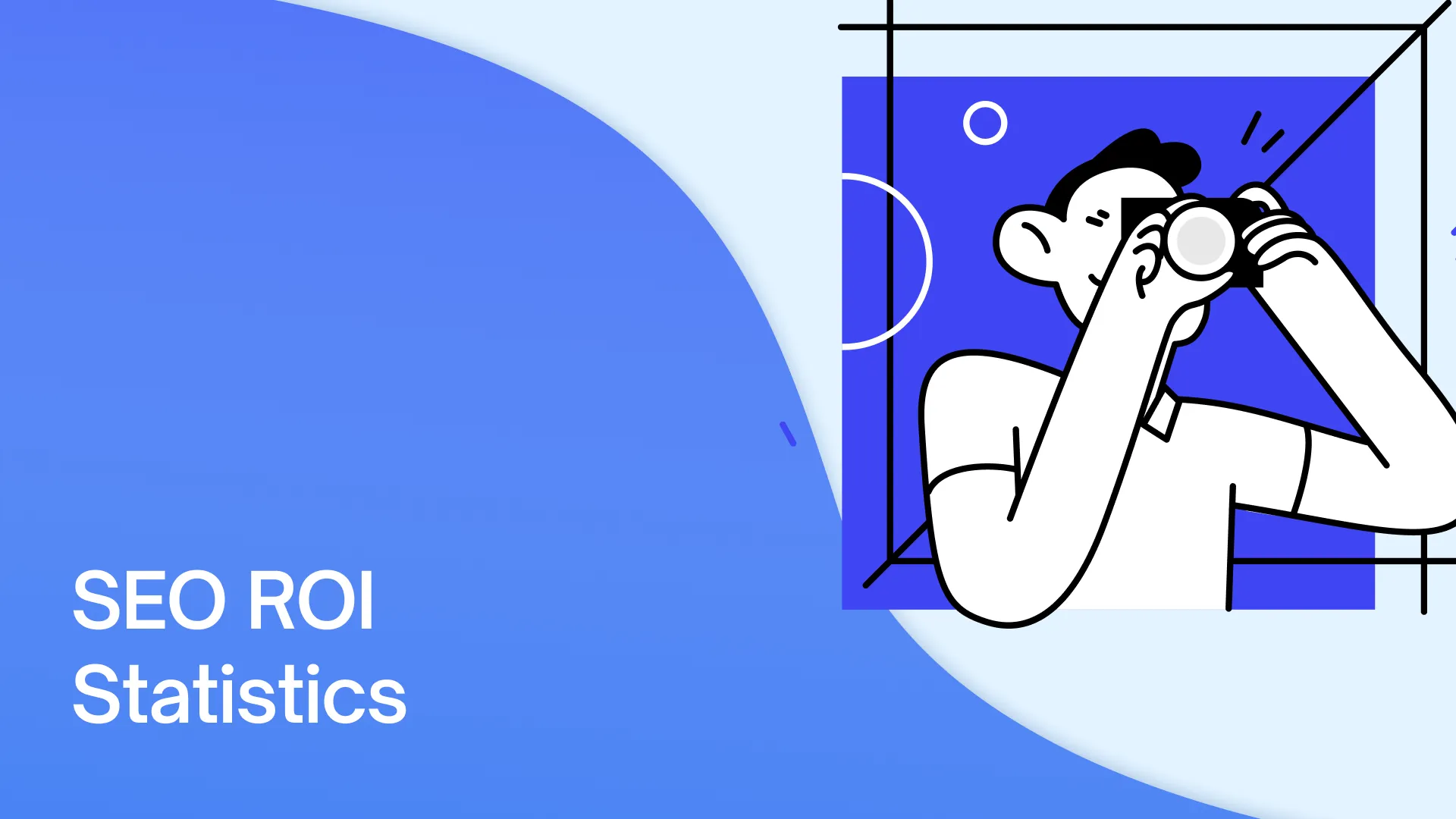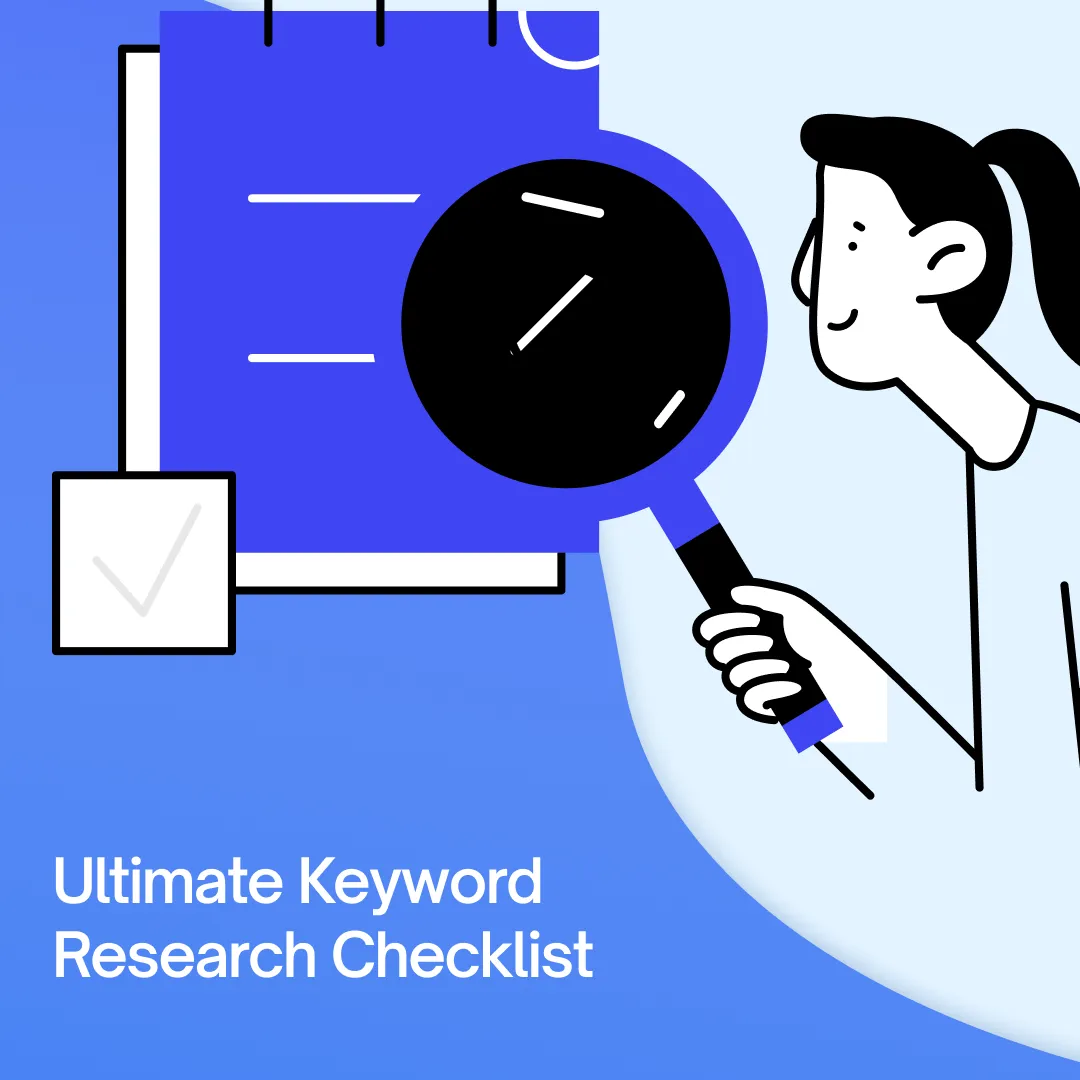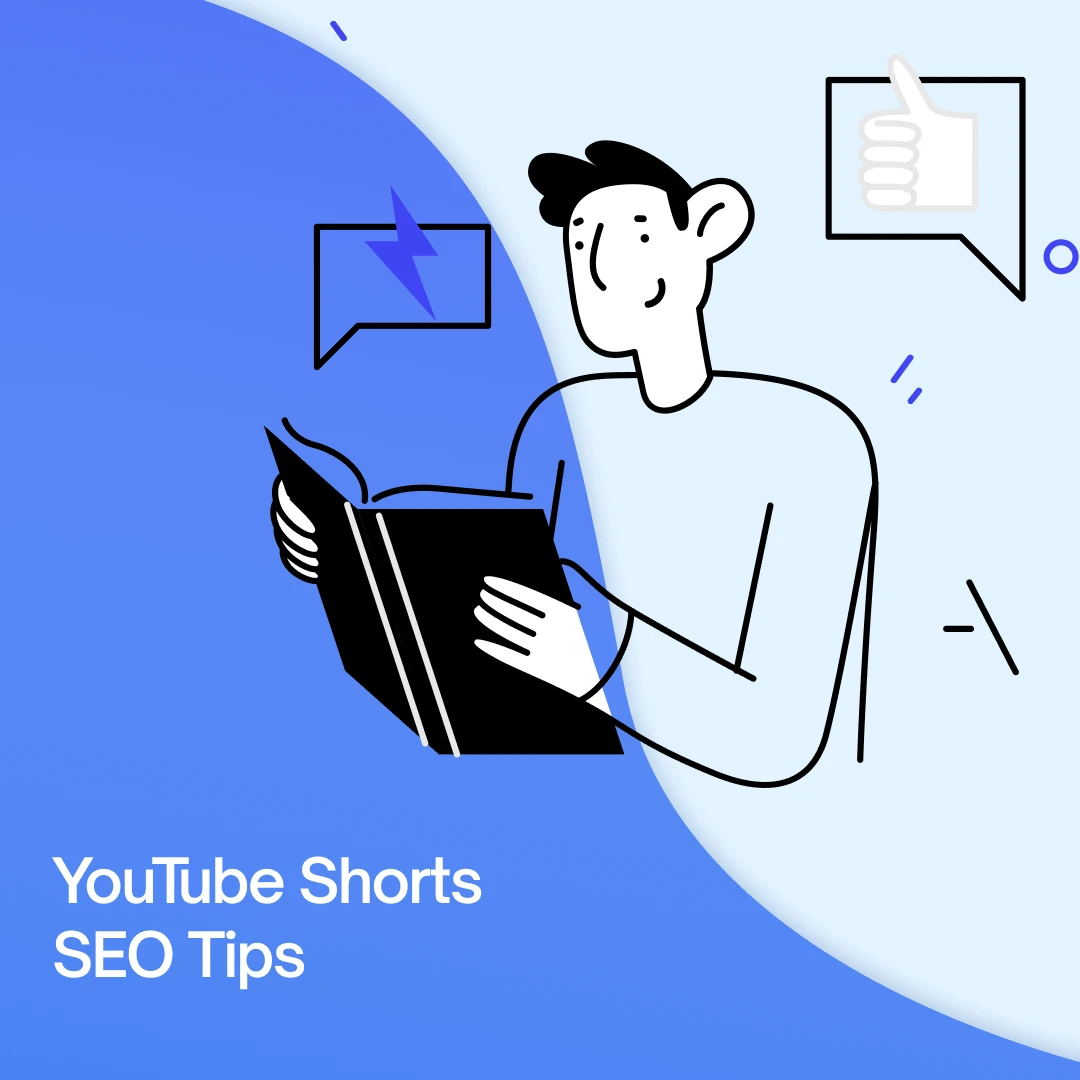SEO strategies look great on paper, but your leadership wants real ROI.
This article delivers 70 up-to-date statistics you can cite in board decks and budget requests, covering:
- Traffic
- Conversions
- Revenue
- AI search
- And more
Let’s dive in.
Pro tip: Bluethings can maximize your SEO ROI. Read our case studies and see the results for yourself.
Why Follow SEO ROI?
Ranking and clicks feel good. But real leaders care about revenue.
You need to track SEO metrics like conversion rate, lifetime value, and search-sourced revenue.
For that, link search queries to closed deals using GA4, Search Console, and HubSpot.
As a side note, here’s how we present revenue data for our clients:
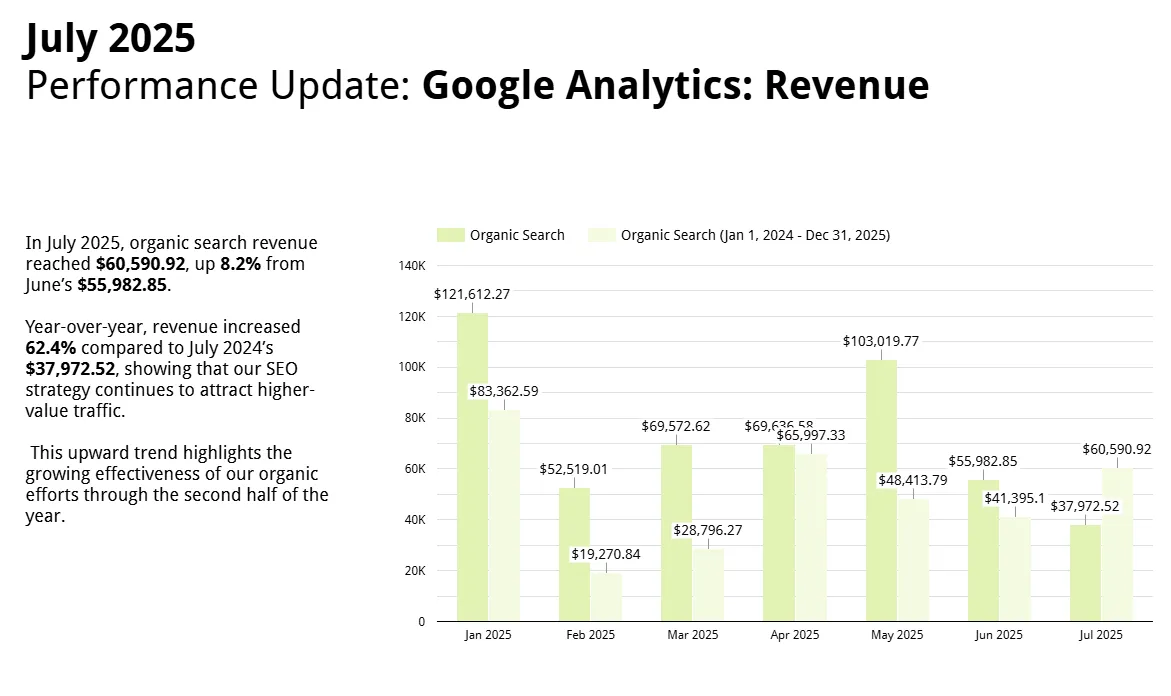
As you can see, we compare organic search revenue by month and year-over-year. We examine ROI trends and what these suggest for our clients.
Then, our clients can use those numbers to compare SEO campaign cost versus lifetime customer value.
The Business Case for SEO ROI in 2025
Search is shifting fast.
AI summaries, Google Lens, voice-search, and YouTube change how users ask questions and how they convert. Mobile-first indexing and Core Web Vitals affect both ranking and conversion.
Google’s AI Overviews and visual search can satisfy intent directly on the results page. And in the majority of cases, they’re pulling answers from a site ranking in position 21+ while ignoring the one in first place.
That’s why SEOs are moving from simple keyword research to technical SEO, schema markup, image and video SEO, and local SEO. These are now the measurable levers that improve authority and clicks.
The problems are that:
- Many of these same innovations also mean fewer clicks and impressions to your website.
- Search visibility has become more fragmented and less predictable.
- Traditional KPIs like sessions and CTR tell an incomplete story.
- Moving from traditional tactics to new approaches can confuse your clients, especially if they find it hard to prove SEO ROI the old way.
That shift can make it seem like SEO ROI is declining. After all, your traffic drops, impressions shrink, and dashboards look flatter.
But in reality, the value of SEO hasn’t decreased; it’s just harder to measure.
Users still discover brands through organic search, but they just do it in new ways: through summaries, snippets, YouTube results, and AI-driven recommendations.
This is why tracking SEO ROI is more important than ever if you want to prove business impact.
We advise you to connect Search Console, GA4, and CRM data to map how organic visibility drives revenue, even when attribution isn’t straightforward. These tools measure not only organic conversions but also assisted revenue, influenced leads, and lifetime value.
Of course, measuring ROI in this environment requires new thinking and cross-functional collaboration. Attribution is harder when traffic spreads across formats (videos, images, local packs, and AI summaries).
Your SEO strategies must evolve to align with brand visibility, entity authority, and customer journey impact rather than just keyword positions.
That’s why we advise our clients to rethink how they evaluate organic success:
- Lower customer acquisition costs from organic-first funnels
- Compounding value from evergreen visibility
- Cross-channel influence (SEO improving paid efficiency and brand lift)
- Long-term authority that supports AI-driven discovery
70 Verified SEO ROI Statistics
This section lays out 70 verified statistics showing exactly how SEO drives revenue, traffic, and conversions.
You’ll see which tactics deliver results, which industries dominate, and where executives should focus attention.
Every stat here comes from a credible source. You can use them to guide strategy, make investment decisions, or justify budget moves.
Let’s start:
Major SEO Channels and Their Market Share
1. Organic search accounts for roughly 53% of trackable website traffic.
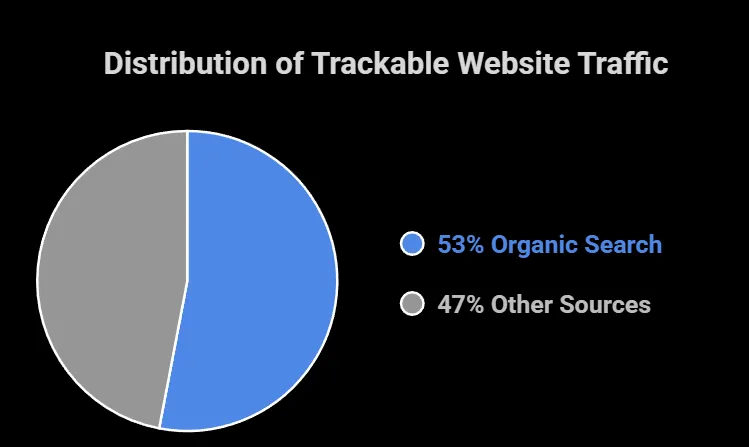
2. The global market for SEO was $82.3 billion in 2023, but will reach $143.9 billion by 2030.
3. Google holds ~90% of the global search engine market share as of 2025.
4. Mobile search is overwhelmingly Google. Google’s mobile search share is north of 94% in many global reports.
5. 89% of purchases begin with an online search.
6. Approximately 96% of internet users, equating to about 4.97 billion people, access the web via mobile devices.
7. 56% of people use their mobile phones while in physical stores to research product information.
SEO Results: Clicks, CTR, and Zero-Click Trends
8. In 2024–2025 research, only 41.5% of Google searches sent clicks to the open web. The rest were either zero-click searches or started a new search.
9. Top organic spots capture the bulk of clicks. The #1 result averages ~27–39% CTR depending on the study.
10. The top three organic results receive roughly 50–69% of clicks on a SERP.
11. Securing a featured snippet in Google's search results can significantly enhance your click-through rate (CTR). Featured snippets capture approximately 67% of clicks, which means they’re very good at driving traffic to your website.
12. Zero-click queries increased materially with AI features; some studies show AI Overviews correlate with CTR drops of 15–35% on affected queries.
13. 95% of users continue to rely on search engines, even if some of them use generative AI platforms for search, too.
Here is more information on zero-click searches and what the future has in store for us:
SEO ROI from Organic Traffic Quality and Intent
14. Organic visitors show higher purchase intent than many social channels, translating to stronger conversion or downstream revenue.
15. Organic search traffic exhibits the highest engagement, with an average of 5.8 pages per session. This is more than other traffic sources like paid search and social media.
16. 34.71% of all Google searches are long-tail queries containing four or more words.
17. Approximately 79% of news-related searches on Google end without a click to an external site.
18. Only 0.69% of Google searches are transactional. Most of them are informational (52%) and navigational (32%).
Pro tip: Need SEO management that converts? At Bluethings, we increased Axify’s SEO performance by 175% and got 300% more qualified leads for Arielle.
SEO Conversions, Revenue, and AOV Signals
19. Global ecommerce average conversion rates hover around 2.5–3.5%, with vertical variation; use your AOV to convert sessions into revenue.
20. A study found that a 0.1-second improvement in mobile page load time resulted in an 8.4% increase in retail conversions.
21. Reducing page load time below 3 seconds can increase conversions and reduce abandonment metrics.
22. Inbound leads historically cost ~39% less than outbound leads in aggregated studies, improving CAC for SEO-driven inbound flows.
23. Businesses that link organic traffic to CRM closed revenue report cleaner ROI and faster decision cycles.
SEO vs Paid Channels (Efficiency and Lifetime Value)
24. Some studies show SEO amortized over content lifespan usually outperforms paid ads on cost per lead.
25. Many brands find SEO has a lower long-term CAC if content and links are sustained for 12–24 months.
26. ROI comparisons that include lifetime value show SEO outperforming short-term paid campaigns when customer LTV is high.
27. Organic acquisition often produces higher retention and LTV versus single-channel paid campaigns, but only 40% of marketers use SEO for customer retention.
Local SEO and Near-Me Conversions
28. A study revealed that listings in the Local Pack achieved CTRs ranging from 15.1% to 17.6%, with the highest CTR observed for the top position.
29. Over 1.5 billion searches now include “near me.” This shows a local intent, which is likelier to be transactional.
30. Eight in ten consumers search for local businesses weekly.
31. In fact, 80% of local searches end with a transaction.
32. 96% of clients learn about local companies by browsing online…
33.… and 76% of them visit within 24 hours.
Content Marketing and Compounding Returns
34. SEO initiatives typically yield positive returns within 6 to 12 months, with continued compounding benefits in subsequent years.
35. Long, comprehensive pages (often 3,000+ words) attract 77.2% more backlinks and organic traffic in multiple content analyses.
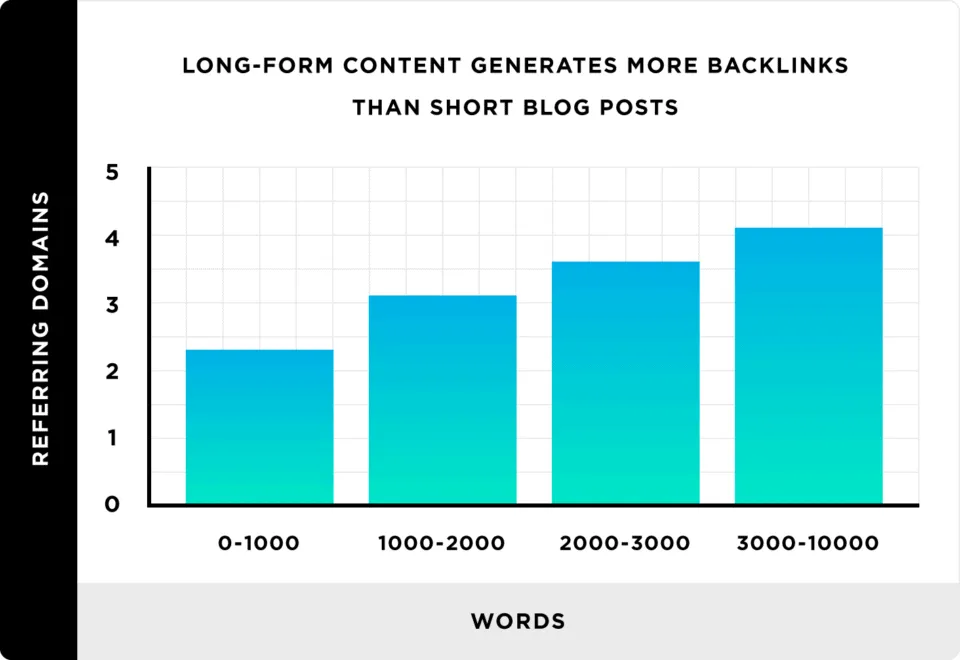
36. Approximately 96.55% of web pages receive no organic search traffic from Google, primarily due to factors like lack of backlinks and suboptimal content quality.
37. Eighty-seven percent of marketers agree that content marketing is great for generating both demand and leads.
38. A 2025 study analyzed 1 million search results and found that websites employing topic clusters experienced higher rankings across multiple queries by covering different angles of the same subject, rather than competing for a single keyword.
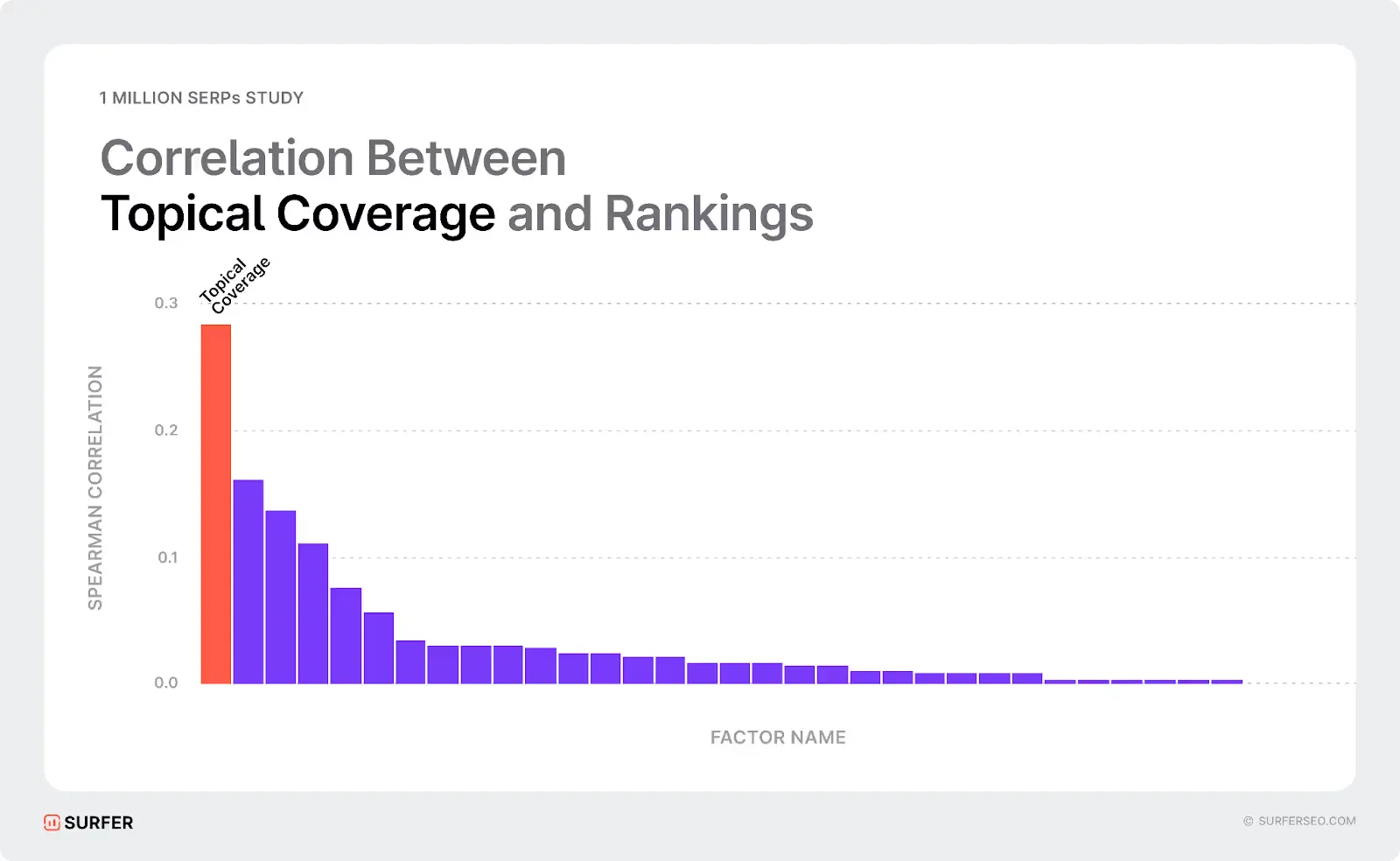
Backlinks, Authority, and Link Building ROI
39. Backlinks remain a key ranking factor, but not in the top 3 anymore. Quality is more impactful than quantity. A few backlinks from relevant and authoritative websites are more beneficial than numerous low-quality links.
40. Targeted link-building efforts can lead to significant ranking improvements within 6 months, particularly when aiming for competitive keywords.
Technical SEO, Core Web Vitals, and UX Metrics
41. Core Web Vitals are an explicit Google ranking signal and correlate with engagement improvements when optimized, such as 3-7% higher conversions and 17-49% drops in bounce rates.
42. An A/B test revealed that improving CWV metrics led to a 53.4% increase in revenue per visitor and a 15.2% higher average order value.
43. First-page Google results tend to load faster ( ~1.65 seconds first-contentful point), which correlates with better CTR and conversion.
44. If you want to increase organic traffic fast, you need to start fixing crawl errors, broken links, and duplicate content.
Pro tip: Want to fix your technical SEO? Our detail-oriented team of experts combs your website to find and fix technical SEO errors.
SEO Queries and Keyword Research
45. Approximately 92% of all search queries are long-tail keywords, which are specific, multi-word phrases that reflect focused user intent.
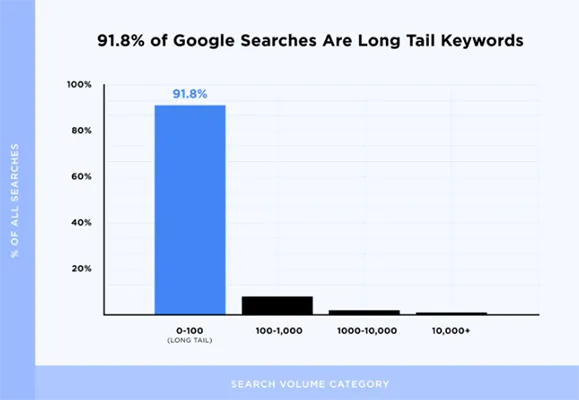
46. Title tags and meta descriptions remain powerful levers to lift CTR by 5.8% without changing rank.
47. Query-level analysis using Search Console plus a keyword tool (Ahrefs/Semrush) reveals revenue opportunities missed by generic keyword lists.
Video, YouTube SEO, and Visual Search ROI
48. YouTube is the world’s second-largest search platform with 2.5 billion monthly users; video content is now a primary discovery path for buyers.
49. Captions and structured video metadata improve discoverability and can increase watch time and conversion for product videos.
50. Shorts and short-form video are massive: YouTube Shorts reached huge daily view milestones, currently over 200 billion, increasing discovery for brands.
51. Google Lens handles roughly 20 billion visual searches a month, and 20 percent are shopping-related, which creates new conversion paths for product pages.
Pro tip: Interested in boosting your YouTube SEO? Here are the best YouTube SEO services to turn that plan into a real result.
Voice Search and Conversational Queries: Organic Traffic and Leads
52. 76% of smart speaker users run local voice queries every week, Invoca states. These contribute a measurable 46% share of local and informational searches, especially for “questions” style queries.
53. 58% of consumers use voice search to find information about local companies, according to BrightLocal research.
54. 28% of those people end up calling the business, BrightLocal states, which is an advantage because…
55. … phone calls convert to 10-15x more revenue according to Invoca.
Sector and Conversion Nuance (B2B, B2C, Local)
56. In 2025, 90% of online B2B content receives no organic traffic. This underscores the critical need for content depth and trust signals to enhance visibility and engagement.
57. Local businesses see higher on-site conversions from search when GBP, reviews, and schema are optimized.
58. E-commerce product pages that integrate high-quality images, schema markup, and video content can experience a higher Average Order Value (AOV) by up to 26%.
SEO ROI timing and Compounding Effects.
59. SEO investments typically begin compounding within 6 months and often show the majority of ROI in 12–24 months, says First Page Sage.
60. Content that ranks takes time to age. According to Ahrefs data, almost 73% of top-10 pages are over 3 years old, which means ROI accrues over time.
Pro tip: Interested in getting results within a quarter instead of three years? For our client Hurom, we increased blog clicks by 262% in just three months.
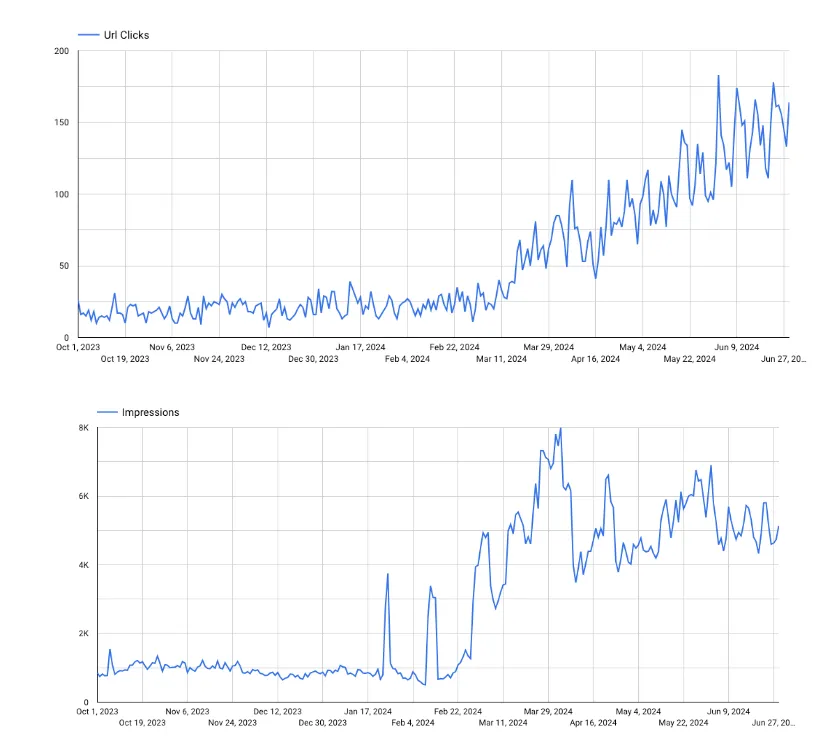
61. 61% of mobile users won’t return to your website if they had trouble accessing it. That’s why you should make investing in mobile usability a priority.
62. The YouTube mobile site contributes 4.23% of all U.S. referral traffic per visitor, surpassing its desktop counterpart at 2.42%.
63. 91% of marketers agree that SEO helps them reach their marketing goals.
64. 83% of marketing leaders now consider demonstrating ROI as their top priority, up from 68% five years ago.
65. 81% of marketers say they have a positive SEO ROI.
66. You can expect three times more leads from content marketing than traditional advertising and with a 62% lower budget.
67. 91% of companies report high ROI on video content, with its use continuing to rise.
68. In 2024, average publishing decreased, though engagement saw a 20% increase. This shows that content quality is more important than quantity.
69. Implementing good RevOps practices can lead to an up to 200% increase in digital marketing ROI.
70. 93% of CMOs and 83% of marketing teams report clear returns on investment from Generative AI (GenAI), with applications in content generation, trend analysis, and customer journey mapping.
SEO ROI Lessons Learned
After going through all these statistics, here’s what you can learn from them:
SEO vs Paid Channels ROI Statistics: Cost Efficiency and Conversion Value
SEO often wins on lifetime cost per lead. Paid ads deliver fast volume. Organic search delivers sustained value after the initial investment.
Look at the numbers.
From what we’ve seen above, organic channels capture a majority of trackable traffic, so the same landing page can earn paid and organic value over months.
Paid search converts earlier in the funnel.
However, from our experience, SEO typically outperforms PPC on cost per lead when you amortize content and link acquisition over 12–24 months.
Let’s assume an example: 1,000 paid clicks at $2.50 each cost $2,500 for a month. One thousand organic sessions earned from content that cost $3,000 to produce and rank over a year will continue driving traffic for 12–36 months, lowering the effective CAC each month.
Remember: Use Google Analytics 4 (GA4) paired with Search Console and HubSpot to compare ROAS, CAC, and LTV side by side.
Long-Tail Advantage: Lower Competition, Higher Conversion
Long-tail keywords convert. They show specific intent and less competition.
Multiple studies report that long-tail phrases deliver higher conversion rates than head terms. In fact, the vast majority of queries are long tail, and many convert at multiples of short-tail traffic.
Here’s how it works in practice:
A niche product page targeting “best compact mirrorless camera for travel 2025” will get fewer sessions than “travel camera,” but a much higher purchase rate.
Use Semrush or Ahrefs to find these phrases, then map them to product pages and calculate conversion uplifts in GA4.
Tools like Semrush’s Keyword Magic Tool and Ahrefs’ Keywords Explorer show low-competition long-tail opportunities and estimate traffic value.
Also, run a quick A/B. Optimize title tags and on-page schema for a long-tail landing page and compare conversion per session after 90 days.
Local SEO ROI Statistics: The Untapped Growth Channel
Local search drives real foot traffic and calls.
The data above shows high-frequency local queries and “near me” intent that convert to store visits and purchases. Google also reports billions of monthly visual searches, many with shopping intent.
And the tools are definitely there. Google Lens and Maps amplify product discovery for local retailers.
To reap the results of Google Maps SEO, we advise you to:
- Optimize your Google Business Profile.
- Add accurate hours.
- Push review responses to lift click-to-call and direction clicks.
You can then use BrightLocal or Semrush Local to audit GBP, track local ranking, and measure calls and direction requests. Tie call conversions into HubSpot or your phone system to prove revenue per local lead.
Content Marketing & SEO ROI Statistics: Compounding Returns
Content compounds.
In fact, evergreen and long-form content generates most organic blog traffic and keeps earning for years.
Just to put the math in perspective: A $4,000 pillar post that drives 2,000 organic sessions per month, with a 1.5% conversion rate and an $80 average order value, generates about $2,400 in monthly revenue. Annualize that, and suddenly the ROI picture looks a lot more impressive.
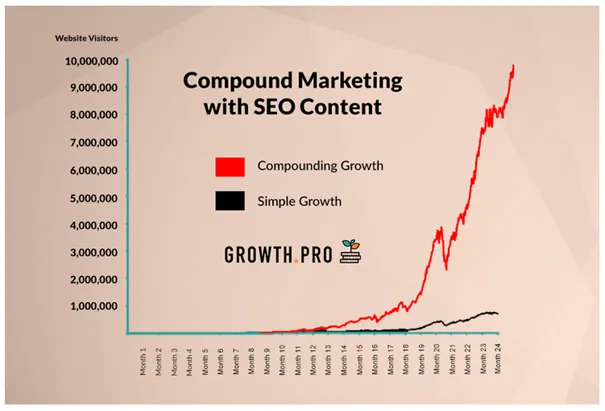
So, create pillar pages and cluster content.
Use HubSpot to track leads from blog posts, then use GA4 and CRM to measure closed revenue. Tools such as Ahrefs, Semrush, and BrightEdge tell you which pages attract backlinks and which keywords supply the most buyer intent.
Expect most content to take 3–12 months to show traction and 12–36 months to fully compound, though, so plan editorial cadence around that timing.
Technical SEO & User Experience Statistics: The Hidden ROI Drivers
Speed and crawl health equal revenue because:
- Bounce rates climb sharply as page load time increases.
- Conversion falls when pages load slowly.
We advise you to follow your Core Web Vitals first to get a measurable Google signal tied to engagement and ranking.
Next, fixing LCP, CLS, and FID can reduce abandonment and increase conversions.
Some of the tools we use are:
- Search Console for crawl errors
- Screaming Frog to find broken links and duplicate content
- PageSpeed Insights or Lighthouse to prioritize fixes
Besides, schema markup and corrected title tags lift visibility in rich results and can increase CTR without any other ranking change.
After doing all these improvements, track revenue impact in GA4 after technical cleanups to calculate pure technical ROI.
Future-Proof ROI: AI, Video, and Visual Search Statistics
Search is now multi-modal, and YouTube remains a top discovery engine with billions of monthly users. You can bet that video SEO and captions will continue to matter for product and how-to queries.
Besides that, AI Overviews and generative answers change CTR patterns but not intent. Pages that own the answer and provide clear next steps still earn conversions, even if AI-related searches increase:
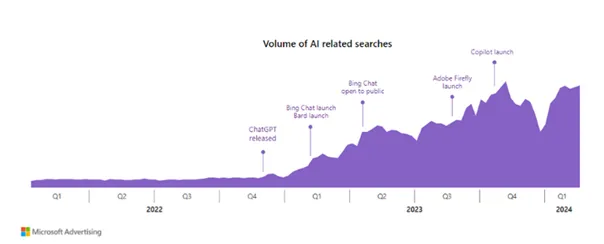
This is generative engine optimization at work. So, we advise you to track how generative snippets affect assisted conversions in GA4. Use video captions, structured data, and image sitemaps to capture visual and video traffic.
Run experiments, too.
Optimize one product page for Lens (image alt, structured image data) and one video for YouTube SEO (captions, chapter timestamps), and compare revenue per visit after 90 days.
How to Measure SEO ROI: Tools, Formulas, Dashboards
Use GA4 to track sessions and revenue, and pull query and impression data from Search Console. Then, combine both datasets in HubSpot or your CRM to see closed revenue.
Add tools like Ahrefs or Semrush to get a sense of your keyword landscape, backlinks, and competitor insights.
A simple formula to gauge ROI is: sum of (page sessions × conversion rate × AOV) for your tracked landing pages, minus SEO costs.
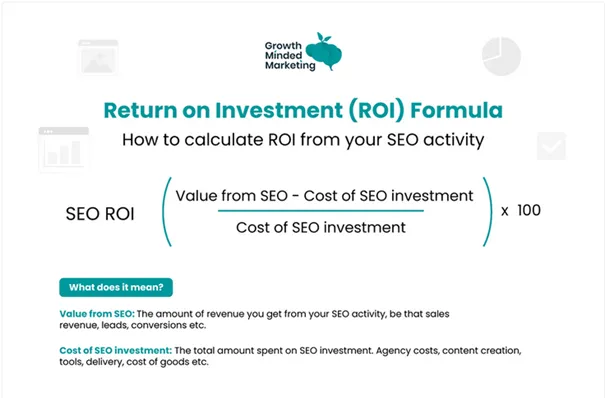
Key dashboard metrics should include organic traffic, conversion rate, revenue per visit, ROAS/ROI, backlinks earned, Core Web Vitals trends, and assisted conversions.
Keep an eye on pages with high impressions but low conversions. They might need tweaks to title tags, schema, or UX.
Pro tip: Track rolling 12-month revenue per visit and compare it to paid channel ROAS. This makes it much easier to justify reallocating budget to SEO.
Optimize Your SEO ROI with Bluethings
SEO remains the top long-term channel for compounding ROI in 2025.
Organic search still drives the majority of trackable traffic. But what matters now are conversion, revenue, and lifetime value. So:
- Measure properly.
- Tie queries to closed deals.
- Optimize web pages, video content, images, and local profiles.
If you need help proving search’s value to the C-suite, Bluethings runs ROI-first SEO campaigns and builds dashboards that show revenue impact.
Get in touch today to learn more about how we do it.

